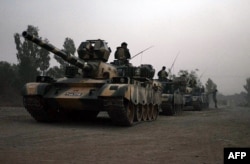For more than four decades, Pakistan has trained and armed hundreds of thousands of Afghan insurgents and hosted millions of refugees in the hope of shaping Afghanistan’s future to its liking.
Islamabad, however, has embarked on a new approach that centers on controlling movement across the long and porous border between the two countries.
Observers say the new policy is unlikely to help stabilize Afghanistan because it won’t prevent insurgents from entering the country but will haunt refugees and border communities whose livelihoods depend on cross-border trade.
“The Pakistanis are not making this into a ‘hard’ border,” said David Sedney, a former deputy assistant secretary at the U.S. Defense Department. “The Pakistan approach of making it harder for legitimate travelers and businesspeople to cross the border will have negative economic, security, and social consequences for both countries.”
Lieutenant General Asim Bajwa, the spokesman for Pakistan’s powerful military, recently outlined the rationale for the new policy.
“[We want] to ensure that no one can go on the other side illegally and no one from Afghanistan can come here except at those [official] crossing points,” he told journalists on September 1. “It will take time, but we have already taken that direction; we are moving ahead steadily, and we are succeeding.”
The new approach -- dubbed “border management” in the official parlance -- is being backed with ambitious security and border control infrastructure across the 2,500-kilometer border known as the Durand Line after the 19th-century British diplomat who demarcated it with an Afghan king.
Kabul has never recognized the line as an international border with Pakistan to the east because it separates some 50 million Pashtuns into the two countries. An estimated 35 million Pashtuns are Pakistani citizens, while the remaining 15 million comprise Afghanistan’s biggest ethnic group. Most are concentrated in that country's southern and eastern provinces.
While relations between Islamabad and Kabul have been a rollercoaster for 70 years, the Pashtun communities in both countries have long thrived on easy cross-border movement.
Islamabad now appears poised to change that.
Bajwa said Pakistan plans to build hundreds of border posts and expand its Frontier Corps border security force in an attempt to regulate all cross-border movement with Afghanistan at 18 border crossings.
“We will build proper gates on all these crossings and post immigration staff,” he said. “Only people with valid documents will be allowed to cross both ways. We will ensure that.”
Since June Islamabad appears to have enforced this new border regime. And the results have troubled civilians and further poisoned the already acrimonious relations between Kabul and Islamabad.
In June, one soldier from each country died during a clash at Torkham, a border crossing that is part of a key trade artery connecting the northwestern Pakistani province of Khyber Pakhtunkhwa to eastern Afghanistan through the famed Khyber Pass.
On September 1, the Chaman border crossing connecting Balochistan Province in southwestern Pakistan to southern Afghanistan opened after a nearly two-week closure.
More noticeably, government harassment in Pakistan forced more than 100,000 Afghan refugees to return to an uncertain future in their country. They are among the estimated 3 million Afghans Islamabad wants to return to their country by the end of the year.
The border closures have devastated Afghan farmers and Pakistani businessmen whose livelihoods depend on cross-border access to markets, goods, and services. But they have made no apparent dent in the raging Taliban insurgency.
With urban attacks and insurgents capturing new territory in the countryside, Afghan and Western officials say the Taliban are engaged in one of their deadliest offensives since the demise of their regime in late 2001.
Sedney, who has served in Afghanistan for years, said the Pakistani plan will leave out thousands of kilometers of unpatrolled border and hundreds of unmonitored crossings across the vast border that includes snowcapped mountains, deserts, and forests.
“The Pakistani measures have had no impact on Taliban shipments of weapons, explosives, money, and fighters across the border,” he said. “[They] are not designed to impact terrorists and are having no evident positive impact on security for either country.”
The new policy has created some domestic political backlash in Pakistan. On September 1, Pashtun leaders of secular and Islamist political parties in Khyber Pakhtunkhwa and Balochistan provinces called on Islamabad to review its new approach. The two provinces share a border with Afghanistan, and their residents are impacted by the negative economic consequences of border closures and refugee harassment.
Sedney said Islamabad’s new approach is unlikely to win any hearts and minds in Afghanistan, either. He said an overwhelming number of Afghans hold Islamabad responsible for Taliban violence and are deeply offended by how their compatriots are treated in Pakistan.
He said both factors have enhanced Afghan enmity toward Pakistan over the past decade.
“Few Pakistanis seem to realize just how extensive and how debilitating for the future this negative dynamic is,” he noted.
fg/









